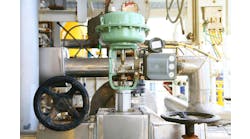Process control valves may not look like finely tailored suits, but the right one can fit a user's needs and application better than the sharpest Giorgio Armani.
To help "outfit" its users in the life sciences and food and beverage industries, Emerson Process Management's Fisher Valves division is exhibiting two new valve technologies during this week's Emerson Global Users Exchange 2010 at the Henry B. Gonzalez Convention Center in San Antonio, Texas. The first of the two valves, the Baumann Type 11000 sanitary throttling disk valve, has been in development for 12-15 months, but this work isn't quite finished yet, and so it's scheduled for release next summer. Still, users can get a sneak peek, and check out a prototype in the event's exhibit hall.
"Our research found that the life sciences and food and beverage industries needed better control than they were getting from lined butterfly valves," says Eric Kuebler, Fisher Valve's sales application engineer. "Many were sticking when their disks rotated into their linings, and so they needed to be replaced more often and weren't getting the control they needed."
"Control Disk has inherently equal percentage characteristics and has good control in the 15-70% range of openness, while traditional butterfly valves have linear characteristics, and so they only have good control in the 20-50% range of openness," Kuebler says. "This is because of Control Disk's thicker shape, which gives it better throttling control."
In addition, Baumann Type 11000 has an electro-polished surface finish, which often is required in food and beverage and life science applications. Also, the elastomer materials used in the valve construction meet all of the U.S. Food and Drug Administration's 21 CFR rules and all of U.S. Pharmacopia's Class 6 standards.
The second valve being showcased by Fisher at the event is the Baumann Type 85000 automated pinch valve for life science, pharmaceutical and biotech applications, which are increasingly using disposable tubing, reactors and other components. Fisher developed the valve with help from SciLog (a company that provides disposable filtration step skids), and released it in fall 2009.
"Instead of the usual reactor tank that has to be cleaned and sanitized, the trend now is toward using basically big plastic bags, which can be used as a reactor and then thrown out along with its filtration, tubing and even disposable sensors," Kuebler explains. "Disposable reactors and equipment means users don't have to do clean-in-place (CIP) and sanitize-in-place (SIP) operations, and they also greatly reduce the change of cross-contamination between batches."
However, users of these disposable reactor systems needed a valve that could work with their new equipment. As a result, Baumann Type 85000 was designed to hook around a piece of disposable tubing, which then runs through the valve itself. "As a result, the valve never actually comes in contact with the fluids it's processing," Kuebler says.
Despite this physical separation, Kuebler adds, Baumann Type 85000's DeltaV FieldVue controller is still able to characterize the flow going through the tubing, optimizes it for each individual application, and can maintain that accuracy for different types and sizes of tubing. "FieldVue connects to the actuators with a digital HART signal to the DeltaV system, converts the digital into a pressure signal, and then moves the actuators pneumatically," he says.



